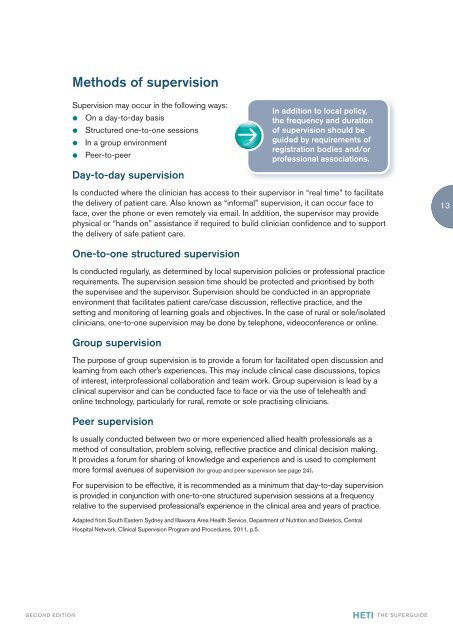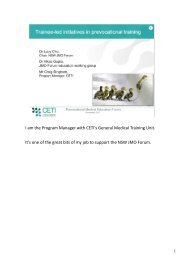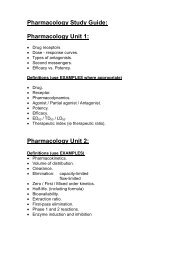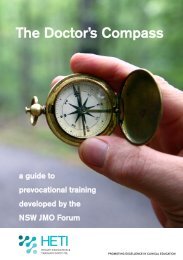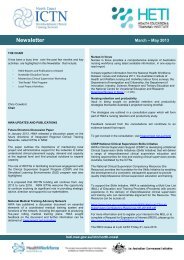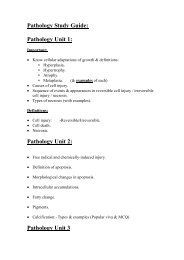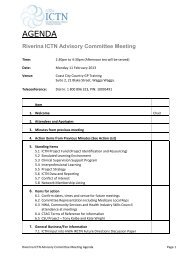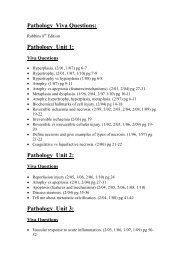a handbook for supervising allied health professionals - HETI - NSW ...
a handbook for supervising allied health professionals - HETI - NSW ...
a handbook for supervising allied health professionals - HETI - NSW ...
Create successful ePaper yourself
Turn your PDF publications into a flip-book with our unique Google optimized e-Paper software.
Supervision may occur in the following ways:<br />
Methods of supervision<br />
• On a day-to-day basis<br />
• Structured one-to-one sessions<br />
• In a group environment<br />
• Peer-to-peer<br />
Day-to-day supervision<br />
Group supervision<br />
Peer supervision<br />
SECOND EDITION<br />
Is conducted where the clinician has access to their supervisor in “real time” to facilitate<br />
the delivery of patient care. Also known as “in<strong>for</strong>mal” supervision, it can occur face to<br />
face, over the phone or even remotely via email. In addition, the supervisor may provide<br />
physical or “hands on” assistance if required to build clinician confidence and to support<br />
the delivery of safe patient care.<br />
One-to-one structured supervision<br />
In addition to local policy,<br />
the frequency and duration<br />
of supervision should be<br />
guided by requirements of<br />
registration bodies and/or<br />
professional associations.<br />
Is conducted regularly, as determined by local supervision policies or professional practice<br />
requirements. The supervision session time should be protected and prioritised by both<br />
the supervisee and the supervisor. Supervision should be conducted in an appropriate<br />
environment that facilitates patient care/case discussion, reflective practice, and the<br />
setting and monitoring of learning goals and objectives. In the case of rural or sole/isolated<br />
clinicians, one-to-one supervision may be done by telephone, videoconference or online.<br />
The purpose of group supervision is to provide a <strong>for</strong>um <strong>for</strong> facilitated open discussion and<br />
learning from each other’s experiences. This may include clinical case discussions, topics<br />
of interest, interprofessional collaboration and team work. Group supervision is lead by a<br />
clinical supervisor and can be conducted face to face or via the use of tele<strong>health</strong> and<br />
online technology, particularly <strong>for</strong> rural, remote or sole practising clinicians.<br />
Is usually conducted between two or more experienced <strong>allied</strong> <strong>health</strong> <strong>professionals</strong> as a<br />
method of consultation, problem solving, reflective practice and clinical decision making.<br />
It provides a <strong>for</strong>um <strong>for</strong> sharing of knowledge and experience and is used to complement<br />
more <strong>for</strong>mal avenues of supervision (<strong>for</strong> group and peer supervision see page 24).<br />
For supervision to be effective, it is recommended as a minimum that day-to-day supervision<br />
is provided in conjunction with one-to-one structured supervision sessions at a frequency<br />
relative to the supervised professional’s experience in the clinical area and years of practice.<br />
Adapted from South Eastern Sydney and Illawarra Area Health Service, Department of Nutrition and Dietetics, Central<br />
Hospital Network, Clinical Supervision Program and Procedures, 2011, p.5.<br />
<strong>HETI</strong><br />
THE SUPERGUIDE<br />
13


